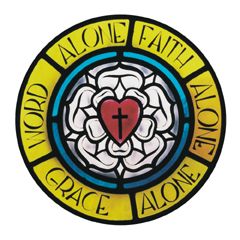Our Beliefs
This congregation acknowledges and accepts all the canonical books of the Old and New Testaments as the inspired Word of God, and all the Symbolical Books of the Evangelical Lutheran Church contained in the Book of Concord as a true exposition of Christian doctrine taken from and in full agreement with Holy Scriptures. —Article III (part) of the congregation's constitution
With the universal Christian Church, The Lutheran Church—Missouri Synod teaches and responds to the love of the Triune God:
- the Father, creator of all that exists;
- Jesus Christ, the Son, who became human to suffer and die for the sins of all human beings and to rise to life again in the ultimate victory over death and Satan; and
- the Holy Spirit, who creates faith through God’s Word and Sacraments.
The three persons of the Trinity are coequal and coeternal, one God.
Martin Luther's Small Catechism is an excellent summary of what the Bible, God’s Word, teaches us. The shape of the Catechism is the shape of the Christian life: Repentance (Ten Commandments), Faith (Creed), Prayer (Our Father), Forgiveness of Sins (Baptism, Absolution, Lord’s Supper), then daily prayer and our daily work. It is very important for us to learn by heart the truths of God’s Word as summarized and beautifully explained in the Small Catechism. (from What About...the Small Catechism)
For more about what we believe as Lutherans, please visit the Synod's website at www.lcms.org/about/beliefs.
So what is it to be a Lutheran?
Being a Lutheran is being a person who believes the truths of God's Word, the Holy Bible, as they are correctly explained and taught in the Book of Concord. To do so is to confess the Gospel of Jesus Christ. Genuine Lutherans, confessional Lutherans, dare to insist that "All doctrines should conform to the standards [the Lutheran Confessions] set forth above. Whatever is contrary to them should be rejected and condemned as opposed to the unanimous declaration of our faith” (FC Ep. RN, 6).
Such a statement may strike some as boastful. But it is not; rather, it is an expression of the Spirit-led confidence that moves us to speak of our faith before the world.
To be a confessional Lutheran is to be one who honors the Word of God. That word makes it clear that it is God's desire for His church to be in agreement about doctrine, and to be of one mind, living at peace with one another (1 Cor. 1:10; 2 Cor. 13:11). It is for that reason that we so treasure the precious confession of Christian truth that we have in the Book of Concord. For confessional Lutherans, there is no other collection of documents, or statements or books that so clearly, accurately and comfortingly presents the teachings of God’s Word and reveals the Biblical Gospel as does our Book of Concord.
Hand-in-hand with our commitment to pure teaching and confession of the faith, is, and always must be, our equally strong commitment to reaching out boldly with the Gospel and speaking God’s truth to the world. That is what "confession" of the faith is all about, in the final analysis. Indeed, "It is written: 'I believed; therefore I have spoken.' With that same spirit of faith we also believe and therefore speak"(2 Cor. 4:13). This is what it means to be a Lutheran.
—from the pamphlet, "What About...Being a Lutheran" by LCMS President Dr. A. L. Barry (2001)
Grace Alone (Sola Gratia)
God loves the people of the world, even though they are sinful, rebel against Him and do not deserve His love. He sent Jesus, His Son, to love the unlovable and save the ungodly.
Faith Alone (Sola Fide)
By His suffering and death as the substitute for all people of all time, Jesus purchased and won forgiveness and eternal life for them. Those who hear this Good News and believe it have the eternal life that it offers. God creates faith in Christ and gives people forgiveness through Him.
Scripture Alone (Sola Scriptura)
The Bible is God’s inerrant and infallible Word, in which He reveals His Law and His Gospel of salvation in Jesus Christ. It is the sole rule and norm for Christian doctrine.

Martin Luther's Rose
First, there is a black cross in a heart that remains its natural color. This is to remind me that it is faith in the Crucified One that saves us. Anyone who believes from the heart will be justified (Romans 10:10). It is a black cross, which mortifies and causes pain, but it leaves the heart its natural color. It doesn’t destroy nature, that is to say, it does not kill us but keeps us alive, for the just shall live by faith in the Crucified One (Romans 1:17). The heart should stand in the middle of a white rose. This is to show that faith gives joy, comfort, and peace—it puts the believer into a white, joyous rose. Faith does not give peace and joy like the world gives (John 14:27). This is why the rose must be white, not red. White is the color of the spirits and angels (cf. Matthew 28:3; John 20:12). This rose should stand in a sky-blue field, symbolizing that a joyful spirit and faith is a beginning of heavenly, future joy, which begins now, but is grasped in hope, not yet fully revealed. Around the field of blue is a golden ring to symbolize that blessedness in heaven lasts forever and has no end. Heavenly blessedness is exquisite, beyond all joy and better than any possessions, just as gold is the most valuable and precious metal.
—from Letter from Martin Luther to Lazarus Spengler, July 8, 1530 [WA Br 5:445]; tr. P. T. McCain